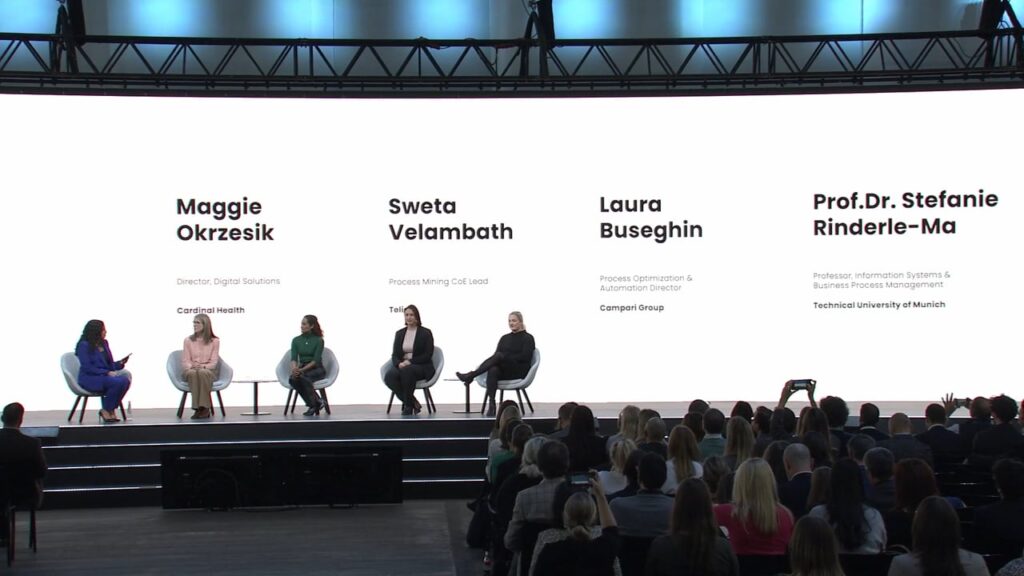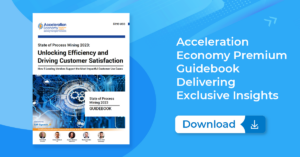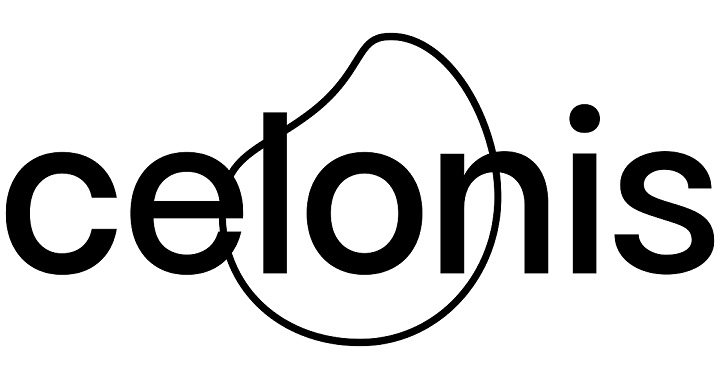At Celosphere 2023, the Women in Process Mining organization hosted a panel discussion called “Women in Process Mining: A Gold Mine of Learnings and Leadership.” The Women in Process Mining community brings together the most powerful women in the process mining field to strengthen their leadership and magnify their influence.
The session was moderated by Christine Hunter, vice president, field marketing North America at Celonis and co-founder of Women in Process Mining. The panelists included:
- Maggie Okrzesik, Director of Process Excellence, Cardinal Health
- Sweta Velambath, Process Mining CoE lead at Telia Company
- Laura Buseghin, Process Optimization and Automation Director, Campari Group
- Dr. Stefanie Rinderle-Ma, Professor, Information Systems and Business Process Management, Technical University of Munich
The panelists shared their experiences with process mining, lessons learned, advice for other women in the field, and the importance of allyship and community.
Process Mining Experiences
Telia embarked on a transformation journey with Celonis technology a couple of years ago. Automation and simplification are its core drivers. Velambath listed process discovery and measurement as vital for its transformation strategy. So far, Telia has implemented Celonis in its finance processes, mainly accounts payable, as well as procurement and customer service.

Cardinal Health has had a partnership with its operational excellence division, which focuses on warehouse operations. The team already uses Lean Six Sigma tools and techniques to improve processes. Okrzesik described this partner relationship, saying the operational excellence division often has fully formed ideas while she gets to be part of helping them produce the data and measure value. “With that team, we started with a really successful dive into customer returns and had a big success there,” she said. “From there, it’s just matured into more opportunities, more success, and more value.”
Dr. Rinderle-Ma has been researching process mining in the manufacturing industry. Currently, she’s exploring and working with object-centric process mining, which is a recent production innovation from Celonis. She is also passionate about pushing the limits of automation and robotic process automation (RPA) to go beyond task automation. Breaking these barriers can unlock more potential and expand insights from process mining while helping to drive optimized results.
Lessons and Advice
Velambath mentions three guidelines that she considers useful for anyone embarking on their journey with this technology. “Dream big but start small – so, aim high, create lofty plans, but maybe start with something simple, less complex and, preferably, with a strong data foundation,” she suggested. She emphasized the importance of collaboration, finding allies and partners, and cocreating to tackle specific business challenges. The third is focusing on the approach rather than the outcome. “Those are the aspects that are going to really help you the more processes you take on and the more business functions you go into.”
Something key, Buseghin says, is working with the leaders of a company’s business functions. Campari Group took a co-creation approach to process optimization with leaders of business functions, which started with identifying the business’s needs. From the beginning, that means “to design with them, to define which are the key metrics for the business, then you have them on board for the full lifecycle — the journey in terms of improvement — and they feel engaged,” she said. Collaborative relationships can enable business stakeholders to see the results not just as something they received, but as something they are building.
Women in Tech
Increasing representation of women in technology needs to start early. “We need to start in the schools to build confidence and then we need to give opportunities,” Buseghin emphasized. She encouraged women to adopt a positive mindset to not just seize the opportunities but to speak up and create opportunities and roles, which can lead to promotions. Women must remember that they are equipped to assert themselves in these ways. “Don’t wait for others to offer us space…be focused on the fact that what we want, we can do it and we can obtain it.”
From her experiences and personal observations, Dr. Rinderle-Ma noted that when they’re young, both boys and girls are equally interested and eager to be in the front row to learn. “We have to think about what happens in between being a child and then growing up,” she said. “It’s important to have role models…because it shows that it’s possible, particularly that you can combine your other life goals with having a career in tech.”
“As women, I think we need to lean into those opportunities when they are presented to us and as leaders, we need to make sure we’re creating those opportunities for the ones that are coming up behind us,” Okrzesik said. It’s vital to consider what we can do now and how we can become allies. Companies need to provide opportunities for technical and soft skills and have more room for advancement. One way for individuals in the tech industry to be an ally is by mentoring or sponsoring a woman, especially one early in her career, Okrzesik recommended.
Final Thoughts
“We have a lot of great superpowers ourselves – and we shouldn’t be shy about those,” Celonis’ Hunter states. Women in the process mining field — and in technology and business, in general — should “take the opportunity and really walk forward in it” when an opportunity is presented. Being allies, sharing experiences, building community, and creating opportunities will continue paving the way for the future women in process mining, she concluded.









